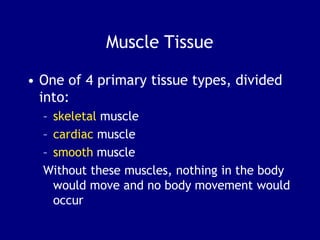Muscle tissue is divided into three primary types - skeletal, cardiac, and smooth muscle. Skeletal muscle is organized into motor units controlled by the nervous system and allows for voluntary movement. Contraction occurs when calcium ions are released, causing the thin and thick myofilaments to interact via cross-bridges, sliding the filaments and shortening the sarcomere. The amount of tension produced depends on factors like sarcomere length, stimulation frequency, and number of motor units recruited. Energy for muscle contraction is obtained primarily through aerobic metabolism of fats and carbohydrates.








































































































































